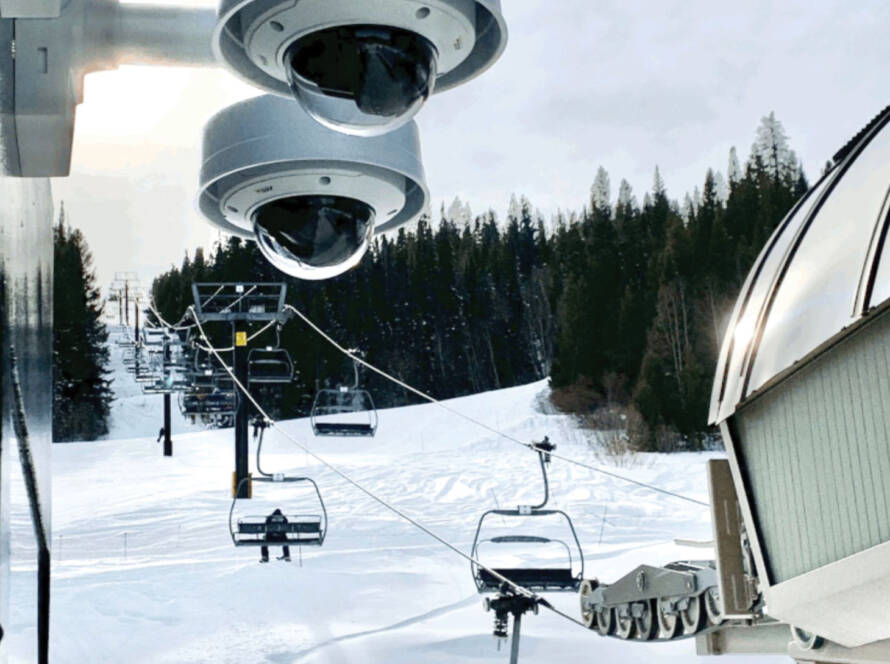Installing or building anything on the side of a mountain presents challenges. Depending upon substructures like rock shelf, sand and soil, these challenges can be daunting. While costs are constantly rising, sometimes new technologies present solutions that improve quality and reduce expenses. The latest example comes from the series of significant storms that destroyed light and telephone poles in Puerto Rico, Texas, Louisiana, and other locations.
The choice was between old wooden poles, galvanized steel, aluminum and even precast concrete. However, none of these materials were able to sustain recently encountered winds, prompting the development of high-strength flexible composite poles. These new configurations are capable of withstanding winds exceeding 200 miles per hour, with significant weight-bearing capacities. This new approach is certainly welcome for municipalities and private sites like snow sports venues because of the material’s resilience and lower cost. Composite materials are about half the cost of metal and potentially 400 percent stronger.
Problems with replacing or installing infrastructure on a mountain come from interfacing with existing wiring and concrete footings, or trenching new electrical conduit and mounting new poles. Formerly, there appeared to be one choice: concrete footings. However, resorts like Steamboat Springs and Hogadon Basin discovered helical piles could significantly reduce costs, time and risks by eliminating the logistical nightmare of hauling concrete up an incline. It is noteworthy that this method can be used for building foundations and chairlift towers.
Helical piles have been used to construct skyscrapers, bridges and other substantial structures. For Steamboat and Hogadon, new lighting infrastructure was installed incredibly fast, saving labor and reducing overhead costs. In addition, helical piles eliminated the risks associated with curing concrete footings. Anyone who has worked with concrete and anchor bolts knows what it’s like if those bolts creep even a centimeter!
The latest development in composite pole design is “direct bury” mounting. This is the same as a wooden telephone pole where the depth of the bury provides the support for the above-grade pole. The problem with direct bury has usually been the subsoil profile. Frequently, the property is not conducive to direct bury applications. New substructure configurations have expanded applications, but every situation must be evaluated relative to soil studies.
Composite poles can be mounted in a hole that is drilled into a rock ledge. It all depends on the nature of the rock: granite versus shale. If the geological structure can support direct bury while satisfying the expected maximum wind loads, this will save significant time and money over using a traditional concrete footing. Moreover, composite poles are more economical than wood, steel or aluminum when considering longevity and maintenance.
Even if the soil and substructure cannot accommodate direct bury, composite poles can be used. The alternative mounting would be helical piles that are screwed into the soil. The helical pile must be designed for the specific soil composition and pole ratings in the same way as a concrete footing. Although helical piles are more expensive, their installation saves the time and effort that would be required when using traditional concrete footings. Risks associated with the concrete cure like temperature variations and potential anchor bolt creeping are also eliminated.
The pandemic has forced snow sports venues to rethink business models and strategic planning to compensate for limited capacity. The obvious way to expand throughput (ticket sales) is to increase operating hours. Economics will depend on the cost to extend hours compared with added top-line revenues. When examining nighttime operations at Midwest resorts and the newer installations at mountains like Steamboat Springs, it is clear that evening hours yield healthy net positive revenues. There is also the added advantage of being able to schedule events at night to avoid interfering with ticketholders or recreational pass-holders who may be put off by daytime events.
Composite poles can be used for more than lighting. The most exciting developing technologies are short-range high-speed internet services that can be interfaced to 5G. Depending on the level of offerings, composite poles can have camera mounts, occupancy counters, communications relays, weather data collection, GPS location hardware and more. Therefore, when considering new pole infrastructure, it is important to plan to ensure separation accommodates all the potentially desired applications. The good news is that composite poles are less likely to be conductors that might interfere with radio frequencies or attract lightning strikes.
Just when it appears there are no more advances for things as seemingly simple as lighting poles, there is a major breakthrough and transition. For sure, Covid-19 has forced the issue: How can a 24-hour, 365-day mountain be maximized? The most obvious way is to expand operating hours.



![[image placeholder]](https://www.snowopsmag.com/wp-content/uploads/2023/09/placeholder@2x-890x664.png)